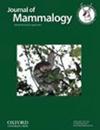白尾鹿(Odocoileus virginianus)鹿角质量的个体发育和静态比例变化
IF 1.5
3区 生物学
Q2 ZOOLOGY
引用次数: 0
摘要
鹿角是一种代价高昂的性状,需要骨骼储备才能长到很大。因此,要深入了解鹿角大小的变化,就必须了解鹿角与体型之间的联系,而这种联系可以通过个体发育和静态比例关系来概括。还需要这两种缩放关系来研究除体重以外的其他因素对不同年龄鹿茸生长的影响,以及这些因素的影响是否会随着年龄的增长而减弱。随着个体试图缓解体型缺陷,饮食和母性的影响可能会随着年龄的增长而减弱。我们研究了饮食和母体属性(母马(母亲)的出生年龄和产仔数)对整个发育期和不同年龄段身体-鹿角质量关系的潜在影响。我们收集了圈养白尾鹿(n = 168)的年龄、母性特征、体质量和鹿茸质量数据,这些白尾鹿从断奶到 5.5 岁死亡期间一直食用低能量(1.77 kcal/g)或标准能量(2.65 kcal/g)食物。这两种类型的比例关系都用线性混合效应模型进行了估计,以考虑雄性、母鼠和父鼠的重复测量。饮食影响了个体发育的比例关系。吃低能量食物的雄性在年轻、体重较轻时的鹿茸生长速度要快于年龄较大、体重较重的雄性,而吃标准能量食物的雄性在不同体重范围内的鹿茸生长速度相似。贝叶斯信息标准模型选择分析表明,饮食和产仔数(单胎、多胎),而不是出生时的坝龄影响了静态比例关系。3.5 岁以下的雄性动物的静态标度系数为正等距(>1.0),而 4.5 岁和 5.5 岁的雄性动物的静态标度系数为等距(1.0)。此外,只有最年幼的雄性(1.5 岁)的截距和斜率受饮食和产仔数的影响,这表明饮食和母性的影响会随着年龄的增长而减弱。体重与安特尔质量的关系很复杂。例如,受母性影响而体型较小的年轻雄性,在年龄较大时仍有可能减轻较小的体型和鹿茸尺寸。本文章由计算机程序翻译,如有差异,请以英文原文为准。
Ontogenetic and static scaling of antler mass in White-tailed Deer (Odocoileus virginianus)
Antlers are a costly trait that require skeletal reserves to grow to a large size. Thus, insight into variation in antler size requires understanding the connection between antler and body size, which can be summarized through ontogenetic and static scaling relationships. Both types of scaling relationships are also needed to examine the influence of factors besides body mass on antler growth at different ages and whether the effects of these factors diminish with age. Dietary and maternal effects might decline with age as individuals attempt to mitigate size deficits. We examined the potential effects of diet and maternal attributes of dam (mother) age at birth and litter size on body–antler mass relationships throughout ontogeny and at discrete ages. Data on age, maternal characteristics, body mass, and antler mass were gathered from captive, pen-raised White-tailed Deer (n = 168) that consumed either a low-energy (1.77 kcal/g) or standard-energy diet (2.65 kcal/g) from the time they were weaned until they perished by 5.5 years of age. Both types of scaling relationships were estimated with linear mixed-effects models to account for repeated measurements of males, dams, and sires. Diet affected ontogenetic scaling relationships. Males eating the low-energy diet had faster antler growth when young and lighter in body mass than when they were older and heavier—whereas males fed the standard-energy diet had a similar rate of antler growth across the range of body masses. A Bayesian Information Criterion model selection analysis indicated that diet and litter size (singleton, multiple births), but not dam age at birth influenced static scaling relationships. Static scalar coefficients up to 3.5 years of age were positively allometric (>1.0), but isometric (1.0) in 4.5- and 5.5-year-old males. Furthermore, diet and litter size influenced both intercepts and slopes in only the youngest males (1.5 years) indicating that dietary and maternal effects can diminish with age. Body–antler mass relationships are complex. Young males that are small because of maternal effects, for example, might still be able to mitigate smaller body and antler sizes at older ages.
求助全文
通过发布文献求助,成功后即可免费获取论文全文。
去求助
来源期刊

Journal of Mammalogy
生物-动物学
CiteScore
3.30
自引率
5.90%
发文量
106
审稿时长
4-8 weeks
期刊介绍:
Papers are published on mammalian behavior, conservation, ecology, genetics, morphology, physiology, and taxonomy.
 求助内容:
求助内容: 应助结果提醒方式:
应助结果提醒方式:


